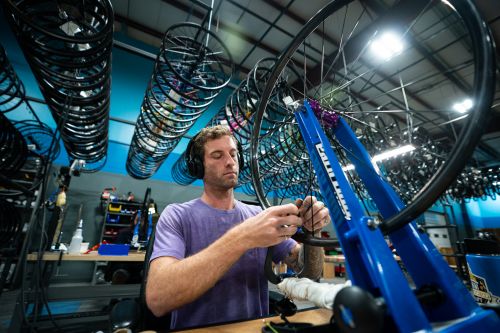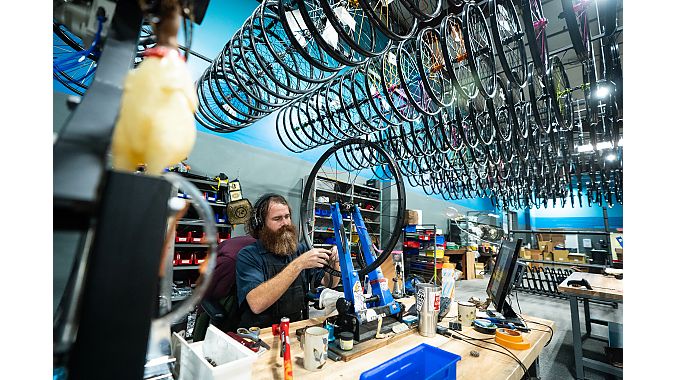A version of this article ran in the October issue of Bicycle Retailer & Industry News.
ASHEVILLE, N.C. (BRAIN) — With Clint Spiegel leading an Industry Nine manufacturing tour, you'll need to hustle to keep up. His enthusiasm for what he and his team accomplish daily obviously puts a spring in his step.
He's not so much in a rush as he is just excited to show and tell his company's story of quickly becoming one of the bike industry's most iconic and innovative brands, growing out of the Turnamics machine shop that Spiegel's dad, Harvey, founded here in 1969.
"When I started at Industry Nine, the machine shop was suffering hard," said Clint, Industry Nine's president. "Probably then we had 75 CNC machines and a lack of work. So when I had ideas for new products, I had machines open. I'd go ride my bike and have an idea. 'I can make this better,' and I'd go into the machine shop and work all night."
Spiegel reminisced in the prototype area amid about $300,000 worth of machines hissing and humming in the background.
"Fast forward to now, and we can't buy machines fast enough to keep up," said Spiegel, who estimates he now has more than 100. Industry Nine also has manufactured some of its own machines — and recently even built its own spoke tension meters when they became scarce because of supply-chain shortages.
To handle its rapid growth at the beginning of the year, Industry Nine, which now has 130 employees, expanded its footprint by purchasing a nearby 142,000 square-foot facility. Other non-bike companies have leased portions of the facility. Its original location, still active, is 58,000 square feet. Hub assembly, wheel-building, most laser etching, packaging, and some prototyping occur at the new facility with machining and anodizing done at the original location.
"When I started close to 12 years ago, i9 was just about 200 square feet of wheel-building, inventory storage, and a service department," said David Thomas, domestic sales and marketing coordinator, during the tour.
OEM business on the rise
Physical growth was needed because of continued financial growth. Revenue was up 43% in 2019; 30% in 2020 (overcoming a slow start because of the pandemic, the second half increased 50%); 57% last year; and 28% through August 2022.
OEM business has more than doubled in the past two years, "and is an important cornerstone for our business," said Vice President Jacob McGahey. "Moving forward, our goal is to meet or exceed the expectations of our existing OEM partners and build new relationships with brands that share our goals: to develop performance-oriented cycling products which truly improve the riding experience."
McGahey added the company will announce additional OEM partners next year.
Spiegel's engaging personality is fitting for a company that first made its reputation on developing the fastest-engaging hubs with a signature buzz, but its ascension was a bit slower.
Industry Nine first worked with nearby Dia-Compe and RockShox in the early 1990s, helping manufacture early suspension prototypes before RockShox broke off and moved to California. Dia-Compe then evolved into Cane Creek in the mid-1990s.
Cane Creek bought the Dia-Compe headset patent and wanted new products after losing RockShox and came to Spiegel to develop a roller clutch hub with more engagement but silent. Spiegel said he couldn't develop it to suit Cane Creek.
"So they dropped the project and then we were pretty much completely out of the bicycle business."
Until about 10 years later.
"I was 34- or 35-years-old. I've had two kids. I've been working until 2 a.m., eating pizzas at midnight. I'm getting fat and out of shape. I'm getting old," Spiegel said. "I've got to start doing something. So I started road biking with some neighborhood guys. And every time I'm riding, I'm starting to think about this hub idea that kicked my ass. And I would come to the machine shop and have a new idea for a new drive mechanism. I made all kinds of crazy, weird, really bad ideas. But the good thing is, if you have an overactive brain and a machine shop, you can run through your bad ideas and refine them, and that was the drive mechanism.
"At the time, I thought maybe I'll just take this and see if I can license it to Shimano. I had no idea what to do."
That was the birth in 2005 of the six-pawl, 120 engagement-points Legacy hub, which almost doubled the engagement range of any gear-driven hub on the market. Now, with the Hydra hub, Industry Nine has increased it to 690 points of engagement.
Spoke innovation seals the deal
Spiegel wasn't done, not with having a machine shop at the ready, so he began working on another idea: a one-piece straight-pull aluminum spoke that threads into the hub flange.
"A better invention than our fast-drive mechanism is our aluminum spokes and the way they're coupled and the strength and the quickness of acceleration," he said.
Innovation comes at a cost, and Spiegel said his drive ring takes 45 minutes to manufacture, compared with 15 seconds for its competitors. Industry Nine spokes take 1 minute and 15 seconds to manufacture, while standard j-bend or straight-pull steel spokes take 1 to 2 seconds, said Spiegel, while standing beside a spoke machine.
"And this is just the machining. It still has to get anodized and laser-etched. And the raw material cost is higher. You look at the wire and you're talking cents of material, about 5-10 cents of raw material. You have to run these machines at about minimum of $60 an hour to have any hope of breaking even. To this day, I think that's the reason why nobody has copied this design."
Industry Nine's decision to offer 11 anodizing colors was the cherry on top that would further distinguish the brand.
"When we first introduced our wheels at Interbike, all these different wheels and all these different colors, it created such a buzz that people were sharing it all over the internet," Spiegel said. "And I was like, you know, in spite of the difficulty (with offering so many colors), it's also free marketing. We started that way and we never looked back."
The company sources aluminum rims from Taiwan and carbon fiber rims from We Are One in Kamloops, British Columbia. Additional carbon rims come from Reynolds, which are manufactured in Asia.
Bearings are supplied by Enduro Bearings.
Component line about to expand
Because of hub and wheelset demand during the pandemic, I9 ha put component expansion on hold, but that will change beginning next year. "Due to the intense pressure on our production resources the last two years, it has been challenging to push forward with some of our product development initiatives," McGahey said. "While a softer sales climate presents some challenges in the short term, it is great to have the extra bandwidth to accelerate product development, and we should have some exciting new product to present in the coming months."
While only stems have been added to its component lineup since the birth of its wheels, plans are in the works for additional new products, including an expanded stem lineup, hub updates, and more.
"Industry Nine is considering all components for the bike," Spiegel said.
About 25% of Industry Nine's machining is non-bicycle related, including giant fiber optic couplers that Spiegel highlighted during the tour. "This is for fiber optic cables going across the ocean," he said. "We make these from corrosion-resistant material."
Before developing bike components, Spiegel said the machine shop suffered from contract-manufacturing clients outsourcing to China, but as its bike business grew, "we took machines that were idle and started making Industry Nine parts. That allowed us to dig out of our financial hole. We had a lot of years with some pretty high losses."
Now that the company is on solid footing, don't expect Spiegel to start slowing down any time soon.
"I've made it clear that I'll never sell this company," he said. "My dad and I own all the shares. If I ever sold the company, the people working in my machine shop ... they're all going to be laid off, and (the manufacturing) is going to go to Taiwan. I'm not going to do that to them. And I believe in manufacturing. And more important than that is we really understand how to make things, so our designs are designs that are manufacturable and manufactured efficiently. Even though our labor costs are higher, overhead is higher and all of that, because we're smarter and we can directly integrate our design to the manufacturing, we can actually be profitable as a result."




